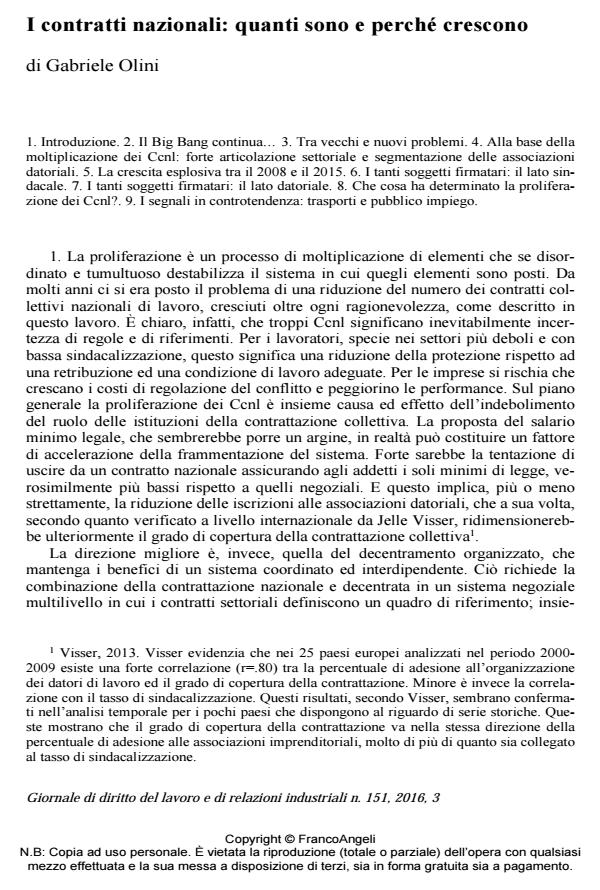National collective agreements: how many are there and why their number is increasing
Journal title GIORNALE DI DIRITTO DEL LAVORO E DI RELAZIONI INDUSTRIALI
Author/s Gabriele Olini
Publishing Year 2016 Issue 2016/151
Language Italian Pages 20 P. 417-436 File size 620 KB
DOI 10.3280/GDL2016-151002
DOI is like a bar code for intellectual property: to have more infomation
click here
Below, you can see the article first page
If you want to buy this article in PDF format, you can do it, following the instructions to buy download credits

FrancoAngeli is member of Publishers International Linking Association, Inc (PILA), a not-for-profit association which run the CrossRef service enabling links to and from online scholarly content.
Sectoral collective agreements in Italy: how much they are and why their number increase so much. From 2008 to 2015 the national sectoral collective agreements increased in Italy from 398 to 706 according to the Cnel’s database. This article examines the reasons for this increase. The number of agreements was already high in 2008, because of the dispersion of employers' organisations and the restricted domain of application. The most recent increase was determined by new agreements signed by other groupings of trade unions outside Cgil, Cisl and Uil with long-established employers’ organisations. But the real surprise has been that recent contracting parties are especially new entries, coalitions of associations of business and labour, creating their space in industrial relations. The paper analyses the consequences of this situation, particularly the critical issue of representativeness, for employers’ organisations too. Also policy lines are proposed in order to reverse the trend towards fragmentation. In recent months there have been some good novelty in critical sectors like transports and public administrations.
Keywords: National bargaining; Trade unions; Employers’ associations; Industrial relations; Representativeness; Statutory minimum wage
- O SINDICALISMO ITALIANO ENTRE CRISE DE REPRESENTATIVIDADE E MUDANÇAS DAS RELAÇÕES INDUSTRIAIS Davide Bubbico, in Lua Nova: Revista de Cultura e Política /2018 pp.287
DOI: 10.1590/0102-287315/104 - Valori e tecniche nel diritto del lavoro Luisa Corazza, pp.167 (ISBN:978-88-5518-483-0)
- L'associazionismo dei datori di lavoro: un elemento di fragilità delle relazioni industriali? Luralba Bellardi, in GIORNALE DI DIRITTO DEL LAVORO E DI RELAZIONI INDUSTRIALI 151/2016 pp.403
DOI: 10.3280/GDL2016-151001 - Collective Bargaining in Labour Law Regimes Mariella Magnani, pp.357 (ISBN:978-3-030-16976-3)
- Pluralismo e rappresentatività sindacale cinquant'anni dopo lo Statuto dei lavoratori. Proposte per una legislazione mirata di sostegno al sistema di relazioni sindacali Pier Antonio Varesi, in GIORNALE DI DIRITTO DEL LAVORO E DI RELAZIONI INDUSTRIALI 171/2021 pp.459
DOI: 10.3280/GDL2021-171004
Gabriele Olini, I contratti nazionali: quanti sono e perché crescono in "GIORNALE DI DIRITTO DEL LAVORO E DI RELAZIONI INDUSTRIALI " 151/2016, pp 417-436, DOI: 10.3280/GDL2016-151002